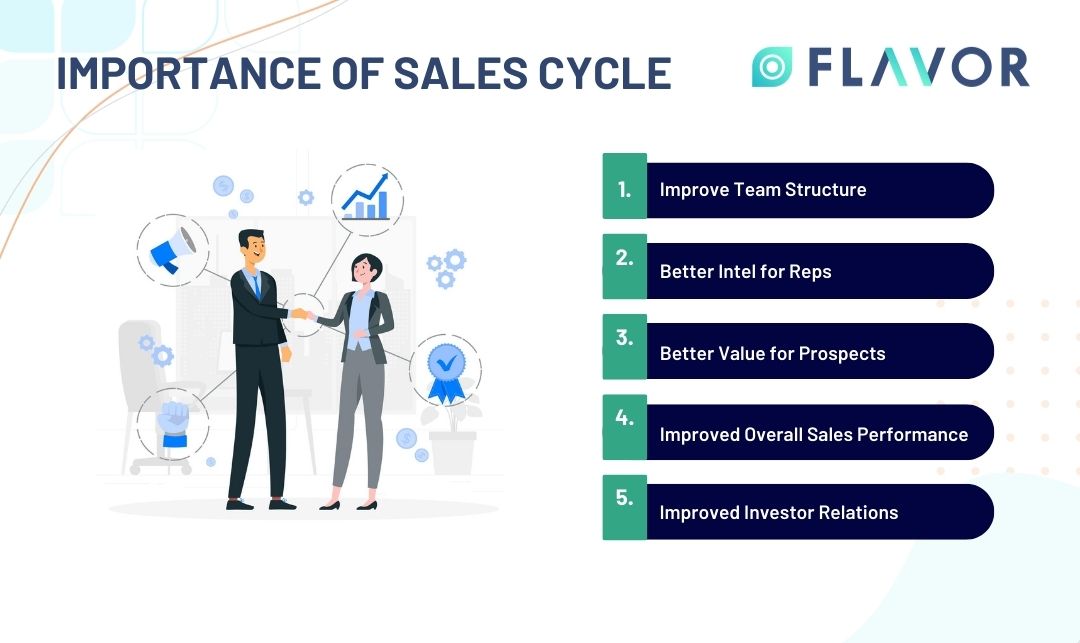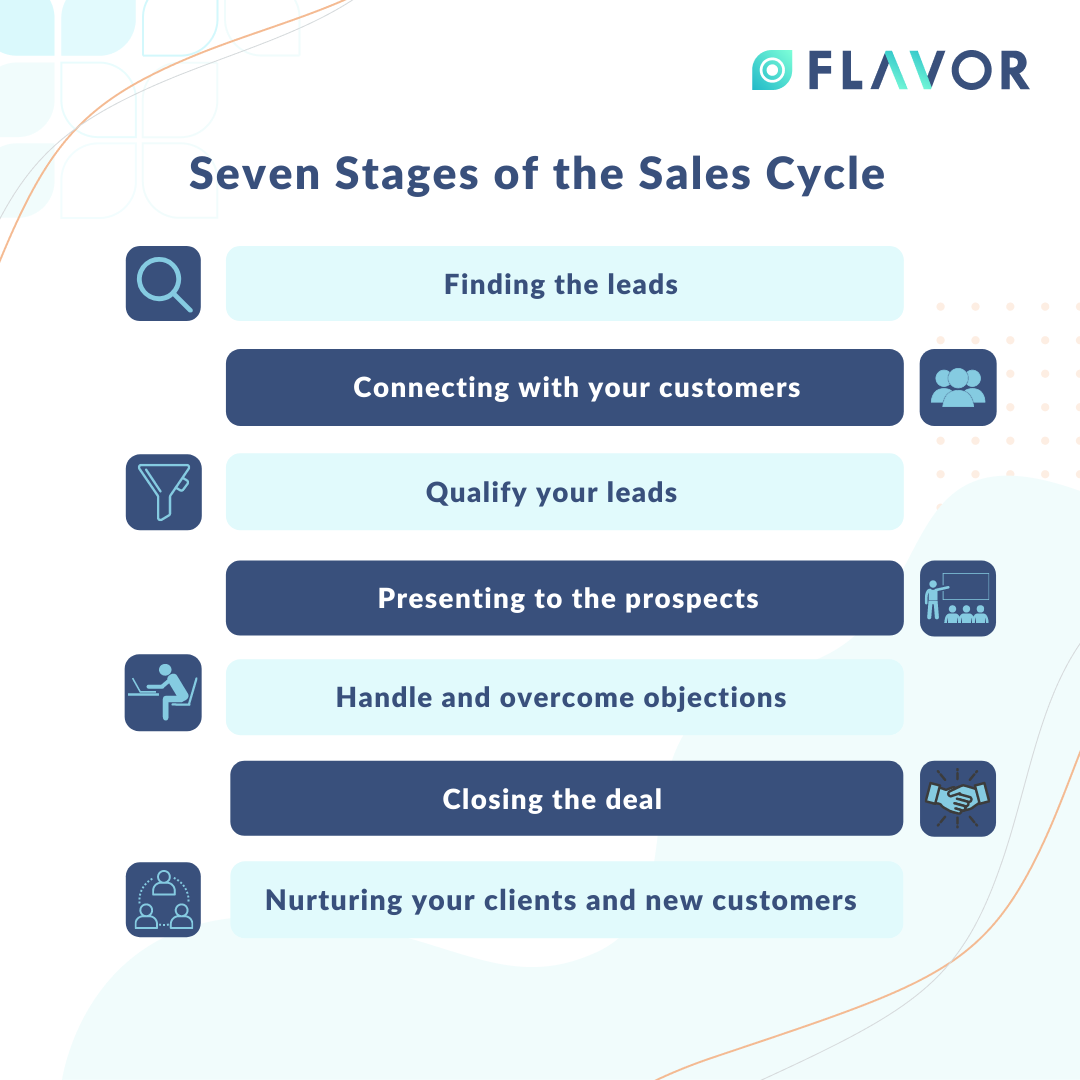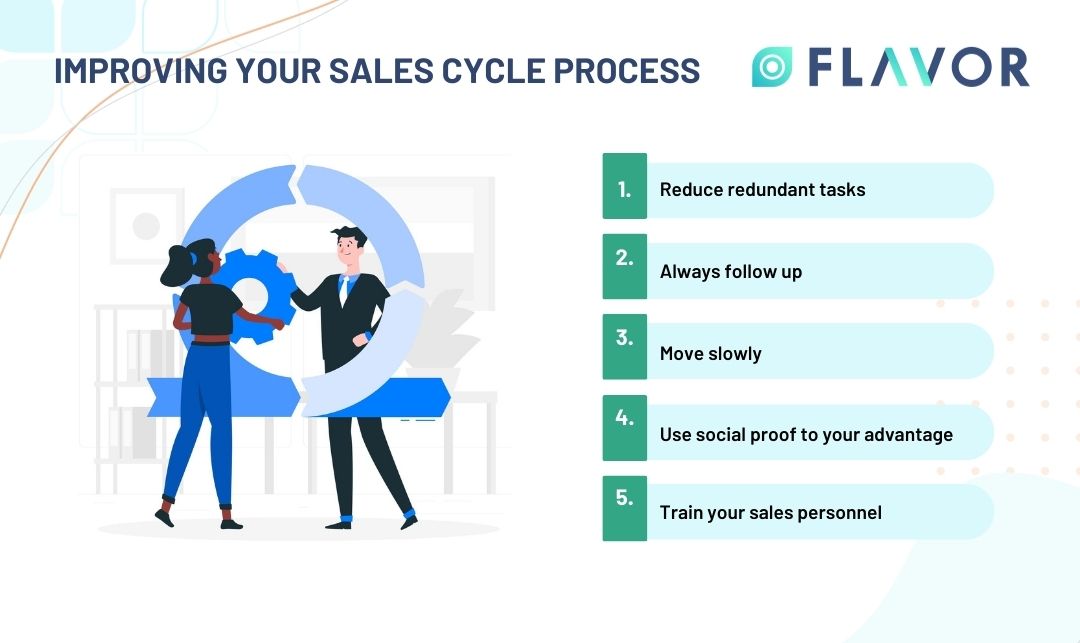A Complete Guide to Sales Cycle: Definition, Stages, and Process

Understanding the sales cycle enables organisations to achieve success more consistently. No wonder that most companies follow a robust sales cycle month after month to hit their sales targets. Doing things the way they come might sound exciting at first, but an unsystematic approach seldom yields any results. The same is true for closing deals in your business. While most companies rely on properly structured sales channels and strategies, others try different things and stick to what works for them at that point in time. But it has been observed that businesses with a proper sales process are likely to generate 18% revenue than those who don’t. And this very structure is called the Sales Cycle.
What is a Sales Cycle?
A sales cycle is a properly defined process of closing deals. Generating leads, following up with the clients, and finally making a sale is the usual sales cycle process followed across the globe. The intricacies of a sales cycle might differ depending on the industry or the product/services a business is selling, but the overall structure remains similar across all sectors.
A clearly defined sales cycle helps an organisation know about the efficiency of its sales operations. Analysing the different stages of a sales cycle at a micro-level will let you know what you did well and where you can improve. Such analysis can help organisations improve their sales and revenue generation in the long run. Since the market and customer behaviour are volatile and continue to evolve, it is important to have a system in place that gives you a chance to understand things and improve.
Why Is the Sales Cycle Important?
Sales cycle is a process that ensures that a customer is satisfied with the purchase and knowledgeable about the product's features. It starts with the customer's interest in a product and moves on to negotiation, commitment, and completion/follow-up stages. Each stage has specific steps that need to be followed in order for the sale to happen. This ensures that the customer is well-informed and that the product is properly marketed and sold.
The cycle is important because it helps to make sure that the customer is getting the best deal possible and that the product is of the best quality. Without a sales cycle, it would be difficult to properly market and sell a product. So, make sure to follow it carefully, and you'll be on your way to a successful sales process!
1. Improve Team Structure
A successful sales cycle starts with a well-defined team structure that is able to carry out the process in a systematic way. Changes within your team or changes in the market can lead to disruptions and confusion, which can ultimately affect your sales numbers. A good system will help manage these changes and ensure smooth sailing for your business. A well-planned sales cycle begins with knowing your customer's needs - this exercise leads to creating a buyer persona that accurately reflects your target clientele's profile and interests. From here on out, the process should be followed step by step until you reach the close of deals - ensuring all contingencies have been planned for and potential problems averted. The rigour of this process helps build trust between buyers and sellers while maintaining predictability; each stage is designed to yield better results than the last
2. Better Intel for Reps
It is important that sales reps are well-informed so they can close deals in a timely manner and deliver the best customer experience. There are different stages to this process, and it's important for sales reps to be aware of them all! Pre-qualification is the first step in the sales cycle, where sales reps research potential leads. They use data such as company size, revenue, etc., to determine if a lead is qualified or not. If a lead isn't qualified at this stage, it will be moved on to qualification next. Qualification involves getting more information about the customer - what their needs are and whether your product or service matches them perfectly. The sales rep must also confirm pricing and availability before moving forward with negotiations. If everything goes well at this stage, the closing will follow soon afterwards!
3. Better Value for Prospects
Providing a better value for your prospects is the key to getting them to convert into paying customers. By following up with the right people at the right time and providing relevant information, the sales cycle helps take things step-by-step towards a successful close. It also establishes trust - something that's vital in selling products or services.
4. Improved Overall Sales Performance
There are a number of reasons why using a sales process manager can lead to improved overall sales performance. It helps identify potential issues early on, resolving them before the sale occurs. This way, both buyers and sellers feel fully informed and confident during the entire process- from pre-sales discussions to follow-up queries. It also ensures that everyone knows their rights and responsibilities in case of any misunderstandings or disputes. A well-implemented sales process manager is essential to selling more successfully - it will help reduce customer churn, boost customer loyalty, and even increase revenue growth through better ROI calculations!
5. Improved Investor Relations
Investor relations is a process that helps you build and maintain positive relationships with your potential investors. It ensures that sales are conducted in an ethical manner and takes customer needs into account. Following a well-defined sales cycle can improve the chances of selling your product or service to your target investor group smoothly and efficiently. Furthermore, it aids in anticipating any potential issues along the way so that they can be managed as best possible. These practices lead to improved relationships with investors - which leads to increased funding opportunities and overall success for businesses involved in investor relations practices
Seven Stages of the Sales Cycle
There are seven stages of a sales cycle. This classification or breaking down of the entire sales process into stages helps in finding out your strengths and weaknesses. So, if you take twice as long as your competitors to close a deal, you can individually assess the stages and see which stage consumes most of your time. This granular approach helps an organisation invest dedicated efforts into each sales funnel stage rather than shooting in the dark and not getting the desired results.

1. Finding the leads
This is the beginning of your sales cycle process, where you look for people who are interested in your product or services. Once identified, they are added to your sales pipeline. It is good to know who exactly your target audience is as it increases your chances of finding quality leads.
This can be done by:
- Solving your customer’s potential issues on Quora
- Create engaging videos that have built-in lead generation forms
- Leads can be generated through support-ticket conversations
- Engage with prospective customers on LinkedIn and other similar sites
This is not the time to make a sale, especially if you are dealing in B2B sales. Your aim at this stage is to simply gather potential leads and determine whether they match your buyer persona. All the information related to these leads can be integrated into your CRM system for future use.
2. Connecting with your customers
The more you know about your prospective customers, the better your chances of making a successful pitch. In the second stage, you must find out everything about your customers, their needs, and their pain points. If you are a B2B vendor, knowing about the company history, top clients, business type, key competitors, industry knowledge, etc., is a few things you must know. This will allow you to have a spot-on first communication with them. Remember, the first call or the first email sets the tone for future communications. So, you must be prepared well before you make the first move. It’s still not time to make a sales pitch. Provide an overview of what you are offering – your products and services and assess if they are ready to move to the next stage.
You can identify this through the BANT technique:
- Budget: Do they have the right budget to avail of your products/services?
- Authority: Does your point of contact have the authority to sign the deal?
- Need: Does your contact person/organisation need your product/services?
- Time: An achievable time frame of when they can make the purchase.
3. Qualify your leads
Not every lead you connect with will make a purchase; you would need to turn them into prospects. Leads are those who might or might not be interested in your products/services or don’t have the resources to make a purchase. Prospects, on the other hand, are both interested and have the resources as well. These are the people who you need to chase. But how do you identify between the two?
Ask the following questions about your leads:
- Is the lead interested in your services/products?
- Do they recognise their need for the services/products you are offering?
- Do they have the resources?
- Is your contact person the final authority to make the decision?
If you don’t get a big “YES” as an answer to all the four questions, your lead is probably not qualified to be a prospect. You can move on to your next option. But don’t delete this contact from your list yet. They can turn into a prospect six months down the line. So, keep their contact information handy for the future.
4. Presenting to the prospects
Now that you have identified your leads and converted them into prospects, it is time to take the sales process to the next step – share how your products and services can help them. This can be a presentation in the form of a video, in-person meeting, over the phone, or any other mode – whatever way you wish to connect with them, the basic formula remains the same.
- Introduce yourself
- Present them with the problem
- Offer the right solution
- Back your claims with proper data
- Sum things up for them
- Take questions and provide prompt answers
Pro Tip: During the entire course of your interaction with your prospects, focus on how your product and services will benefit them instead of elaborating on the features.
5. Handle and overcome objections
It is highly likely that even a prospect will be inhibited or unsure about your product and services. While most prospects will be already convinced to make a purchase, you might have to further convince the others. Look at their questions and objections as an opportunity to tell them more about your products/services. An unsure prospect and his objections don’t mean that a sale is impossible here. You need to be sharp, smart, and persistent to make it happen.
Some of the common objections you might face include:
- The cost is too high
- I am bound by a contract with your competitor
- We need more features
Pro Tip: The most common objection the sales personnel faces is the price. To counterargue, you can show them the benefits and features you bring to the table and how your product will enhance and help fulfil their needs. Clearly communicate what the prospects will get for the price paid.
6. Closing the deal
Now is the time to hit the nail and get your prospect to sign the dotted line. There are three ways of getting this done.
An assumptive close: You behave as if the prospect has already decided to make a purchase. It’s hard to pull off, but it works.
A suggestion close: Give your prospects suggestions based on their needs.
An urgency close: Provide discounted rates or attractive offers to entice them to make a purchase.
Even if you are unable to close the deal after making all the efforts, don’t lose heart. Your prospect can turn into a customer in the future, so keep following up with them. This is what takes us to the last stage.
7. Nurturing your clients and new customers
Whether your new clients have closed a deal with you or a prospect who might turn into a client in the future, it is important to nurture them and keep the communication channel open. This will not only develop stronger customer loyalty but also give a chance of an upsell or a referral.
You can do this if you:
- Ensuring a smooth onboarding and handoff process.
- Continue providing them with useful material about the products and services like how-to guides, etc.
- Checking with them regularly if they need any help and if you could be of any help.
Pro tip: If you develop a strong relationship with your client, don’t be afraid to ask for a referral. It will only help you widen your customer base and revenue generation.
How to improve your sales cycle process
Regardless of how frequently your sales team is able to achieve its targets, there is always scope for improvement. Here’s how you can optimise your sales cycle process: 
1. Reduce redundant tasks
It has been observed that sales reps spend only 36 per cent of their total time selling. The rest of the time is spent doing administrative work (filing paperwork, manually managing leads and prospect data), and other non-revenue generating or downtime activities.
2. Always follow up
Most sales pitches require follow-ups, and it gives you a far better chance of converting leads into prospects by simply following up with the clients.
3. Move slowly
Ask for smaller commitments and go slow with your sales pitches. For instance, ask for their phone number when you email them or ask for a product demo when you meet them first.
4. Use social proof to your advantage
Using case studies to counter your prospects’ objections, confusion and concerns is a great idea. It helps convince them to move closer to making a purchase. This can be done by giving references from your past customers (phrases like “so many people…,” and “most organisations in this situation…,” are helpful. You can also name companies by citing examples that benefited from your pitch, etc.
5. Train your sales personnel
Training will make your team better at doing what they have been doing well till now. Identify their weaknesses and provide additional resources to enhance their skills. Conduct seminars, pep talks by sales pioneers for better insights. Help them develop soft skills and ‘How to sessions where they can be taught about approaching clients, pitching, selling, etc.
How to Calculate the Length of a Sales Cycle
Sales cycle time is a vital metric for any sales team. It's time it takes to convert a lead into a customer. The more qualified leads you to have, the shorter your cycle time will be! To calculate how long your cycle time is, you need first to understand the sales process stages - warm-up qualified leads and contact conversion stage.
Next, use the equation Sales Cycle Time = Qualified Lead Rate X Contact Conversion Rate to calculate the length of your cycle. Keep in mind that the contact conversion rate is the percentage of leads that leads to sales. So, make sure you're qualifying your leads well!
Important KPI’s
There are several ways to measure your sales cycle to optimize it for better results. By understanding the different stages, you can make sure that your leads are qualified correctly and that sales transactions go smoothly from start to finish. This way, you will be able to achieve the targets set for your business and improve overall performance metrics. To ensure accurate measurement of sales cycle stages, it is important to have a process in place which takes into account all relevant data points such as leads received, contact information collected, quotes sent, etcetera. Recording these statistics on a regular basis will help you identify any potential issues or improvements that need to be made in the next step of the sales process - selling presentations!
Sales Cycle Management Best Practices
Sales cycle management is a process businesses of all sizes need to understand and implement to achieve success. The cycle begins with lead generation and ends with closeout, and each stage requires a specific set of actions and procedures. To stay on top of things, ensure you have a well-defined sales cycle management process covering all sales process stages.
This will ensure quality control, customer satisfaction, and a smooth sales process. Always keep the customer's journey in mind at all times, and follow standardized processes to ensure a smooth and successful sales cycle for your business.
1. Tracking Your Metrics
It is important to track your metrics at each stage of the sales cycle in order to measure your progress and ensure that you are making the right decisions. Knowing the sales cycle can help you manage your business more effectively, as well as anticipate potential issues and take corrective measures before they turn into major problems. There are four stages in a sales cycle - pre-qualification, qualification, negotiation, and closing.
It is essential to have a process in place to deal with objections and complaints at each stage - this will help optimize workflow and prevent any delays or mismatches. Furthermore, it is important to track key metrics such as lead generation rate (LGR), conversion rate (CR), average ticket size (ATS), etc., so you can get an idea of where your team stands overall. By doing all of this, you'll be able to make informed decisions about how best to grow your business further!
2. Keep Detailed Records
It's important to keep a close eye on your sales cycle so you can track your progress and make the necessary adjustments. You should also make sure to record all of your outreach efforts (phone calls, emails, etc.), closing dates, budgets, and customer feedback. It is also essential to follow the stages of the sales cycle- Interest, Inquiry, Proposal, Agreement/Contract- in order for everything to run smoothly!
3. Cycle Stages Should Be Modified to Fit Your Sales Process
When it comes to sales, the process should be structured in a way that is easy for you and your team to follow. This will help ensure that sales are made smoothly and without any hiccups. It's also important to have a defined sales cycle so that you can track progress throughout the process.
Depending on the type of business, you may need to adjust the stages of your cycle as your sales process changes. For example, if selling through email marketing involves first getting customer leads before converting them into paying customers, then stage 1 (getting customer leads) would precede stage 2 (converting leads into paying customers).
4. Request for Feedback
Before selling anything to your target audience, it is important to get their feedback. This will help you refine your sales process and improve customer engagement. In the long run, this leads to increased conversion rates and a better understanding of what people want from your products or services.
It's never too late to give Feedback! Start by asking for feedback at the very first stages of the sales cycle - when you're initialising contact with potential customers and during email marketing campaigns. Remember that not all customers are willing or able to provide feedback in a clear and concise way- so be patient while they try their best. However, as soon as they offer some valuable insights, take full advantage!
5. Automate Every Process
If you're selling online, automating your sales process can speed things up and make the customer experience better. There are three stages to a sale -
- prospecting (identifying potential customers),
- qualifying (establishing whether or not the customer is qualified to buy what you have)
- selling (generating a purchase).
Automated tools can help you track progress throughout the cycle so that everything runs smoothly. Furthermore, it's important to follow a standardized sales process so that your customers know exactly what they're getting into when they contact you. This will reduce buyer anxiety and lead to more successful sales conversions.
A robust sales cycle, coupled with efficient CRM software, can help you increase your sales
In the normal progression of things, your business is most likely to get bigger with time, and using the traditional methods for record-keeping might not be enough. But if you automate such manual tasks through an efficient CRM system that a large number of organisations now use, it can benefit you in the long run. You need an efficient CRM system, a system that is capable of handling multiple leads, deals, and prospects and storing them in one central location for everyone to access. It can also track conversions, sales cycles, lengths, and a lot more. This will help you close deals faster and increase customer retention.

